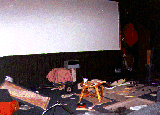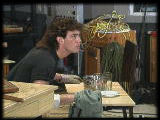|
 Specifics Specifics
|
|
|
|
If the sound is not
a Clothing
Move or
a Footstep
then it must be a Specific! Anything an
actor touches or effects is considered a Specific
and recorded as a separate element often involving
layers of sound.
Specifics are the
real fun in Foley. They allow you to paint with
sound, recreating the actual movements in an
enhanced way. Much of the magic associated with
sound effects is considered a Specific. From face
punches to body falls, Specifics are also a lot of
work!
|
The
Stage After A Fight Scene
|
|
Before
You Begin...
You will need many props for your Specific tracks
(whatever you see in the film!). It's impossible to
say what you will need until you see the picture
and as time goes by you will add to your collection
(if you have space!) - garbage day in my
neighborhood is 'golden day' as I collect some of
best props from the stuff people throw out: old
bicycles, doors, sinks, wood, metal, desks, etc.
Flea markets and the Salvation Army store also
offer a treasure trove of fun and interesting stuff
to listen to (I seldom care what something looks
like but what it sounds like!) Collecting props is
an occupational hazard - Andy Malcolm even went as
far as buying a truck trailer (a big big
trailer!!!) just to store props!
Creating sound
effects also involves some unique time tested
tricks such as:
- Corn
Starch in a leather pouch makes the
sound of snow crunch
- A pair
of gloves sounds like bird wing
flaps
- An
arrow or thin stick makes a great
whoosh!
- An old
chair makes a controllable creaking
sound
- A
water soaked rusty hinge when placed
against different surfaces makes a
great creaking sound. Notice how
various surfaces act as a sounding
board to amplify and change the sound:
this is an important principal of Foley
and sound creation!
- A
heavy staple gun and a other metal
parts make can make a good gun
sound
- A
metal rake makes a great fence sound
(and when scraped across metal makes a
great metal screech - if you can stand
it!)
- You
will need a car door and a fender which
you can pickup at a wrecking yard -
they are good for car and other heavy
metal sounds. If you can fit a whole
car in the studio, even better!
- Burning
black plastic Glad garbage bags (cut
open a bag and strip it into thin
pieces) will make a cool sound as the
bag melts and drips to the ground
THIS IS VERY
DANGEROUS!!!
|
- 1/4"
audio tape when balled up sounds like
grass (we walk on it!) or flowers
- A wet
balloon makes a weird sound when
rubbed: this is funny more than
practical!
- 'Flubber'
(they sell it in toy stores) is great
for wet swuishy sounds; so is gelatin
and liquid hand soap.
- Frozen
romaine lettuce (I used this in the
'War Of The Worlds' television series
for alien head squishes!) makes a great
bone or head squishy noise
- Coconuts
shells cut in half and stuffed with
padding makes great sounding horse feet
(I swear I still use this trick): it
takes some skill to make good sounding
ones (not too hollow or thin) but it
works!
- Cellophane
can make the sound of crackling fire
(the effects editor should do the fire
but in a pinch it does work)
- You
will need a wooden door - apart from
door knocks and other movement sounds,
they make great wooden boat noises when
laid across a heavy wooden stool (the
stool gives the door a resonance and
helps with the creaking
- A
heavy rolled and taped up telephone
book makes a good 'body punching'
surface
|
|
|
How
To Record A Specifics Track...
You will
need a track for each specific sound. Some tracks
last the whole length of the scene (snow crunch or
lapping water) while some effects are very short (a
match strike or a punch) so planning the tracks is
very important. Try to keep like things on the same
track throughout - water on its own track and guns
on their own track - that way the mixer can set the
EQ (Equalization) at a consistent level.
- The microphone
should be placed about three feet in front of
the Foley Artist and away from the face to
reduce the sound of breathing (the mike is so
sensitive it can easily pick up the sound of a
breath.
- You will need
to 'ride the level' more than ever when
recording specifics as some sounds are soft (a
kiss) and some are very loud (a car
exploding)
|
|
How
To Perform A Specifics Track...
You will
need to select the appropriate props as they are
seen in the film. Each prop is your instrument and
you must learn to play it:
- Break each
action into layers of sound. If an actor lights
a match, then perform the sound of the match
movement as the actor pulls one out and then do
the sound of the match strike. There is no
reason it has to be done all at once or on the
same track since you are trying to get the best
sound
|
Fun
in Foley!
|
- Do not try to
match the visual of the prop but rather the
sound. Audio tape sounds just like grass
(without the mess and fuss) but it doesn't look
like it. Understanding how things sound and
storing these records in your head for future
films is the way a Foley artist must think -
play around with objects and combinations to see
what neat sounds they make
- Above all,
animate the sounds - make them bigger than
life
|
|
The
End Result...
With all
the Specifics in place you should have a complete
sounding track! Every nuance, every subtle action
should be covered so well that it sounds like the
original - remember, if you can tell its Foley then
its no good! At the same time however it should
sound bigger than life and almost take your breath
away. When I make people jump or shriek with
surprise at the power of a sound then I know I have
done my job!
|
 Specifics
Specifics

